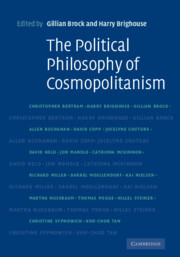Book contents
- Frontmatter
- Contents
- List of contributors
- Preface
- 1 Introduction
- 2 Principles of cosmopolitan order
- 3 Territorial justice and global redistribution
- 4 International justice and the basic needs principle
- 5 Cosmopolitans, cosmopolitanism, and human flourishing
- 6 Global justice, moral development, and democracy
- 7 A cosmopolitan perspective on the global economic order
- 8 In the national interest
- 9 Cosmopolitan respect and patriotic concern
- 10 Persons' interests, states' duties, and global governance
- 11 The demands of justice and national allegiances
- 12 Cosmopolitanism and the compatriot priority principle
- 13 Beyond the social contract: capabilities and global justice
- 14 Tolerating injustice
- 15 Cosmopolitan hope
- Bibliography
- Index
1 - Introduction
Published online by Cambridge University Press: 04 December 2009
- Frontmatter
- Contents
- List of contributors
- Preface
- 1 Introduction
- 2 Principles of cosmopolitan order
- 3 Territorial justice and global redistribution
- 4 International justice and the basic needs principle
- 5 Cosmopolitans, cosmopolitanism, and human flourishing
- 6 Global justice, moral development, and democracy
- 7 A cosmopolitan perspective on the global economic order
- 8 In the national interest
- 9 Cosmopolitan respect and patriotic concern
- 10 Persons' interests, states' duties, and global governance
- 11 The demands of justice and national allegiances
- 12 Cosmopolitanism and the compatriot priority principle
- 13 Beyond the social contract: capabilities and global justice
- 14 Tolerating injustice
- 15 Cosmopolitan hope
- Bibliography
- Index
Summary
GENERAL INTRODUCTION
Nationalism appears to have been on the rise since the mid 1980s. The break up of the former Soviet Union, and the dissolution of the barrier between Western and Eastern Europe triggered the political advance of nationalism in Eastern Europe, as new countries emerged, defining themselves in opposition to the previously existing regimes. Simultaneously, increased immigration from the former communist and from Muslim countries has fuelled nationalist sentiment within Western European states themselves. At its best, the latter development has prompted governments and citizens of those countries to reconsider the meaning of nationality, inducing a more inclusive and multicultural conception of “the nation.” At its worst it has provoked xenophobic backlash.
At the same time, the north–south divide between wealthy industrial and post-industrial and poor developing countries has been an increasing object of political concern. Most developing countries are no longer colonies of wealthy ones, but many bear the marks of a history of domination and exploitation. The post-colonial period in Africa in particular has often been brutal, and the extent of responsibility of the former colonial regimes for what followed independence is not clear, and, whatever its extent, rarely acknowledged by the former imperial countries. The US and the former Soviet Union used Africa and the Middle East as focal points for the Cold War, and it is hard to believe that those regions did not suffer politically and economically as a result.
- Type
- Chapter
- Information
- The Political Philosophy of Cosmopolitanism , pp. 1 - 9Publisher: Cambridge University PressPrint publication year: 2005
- 6
- Cited by



